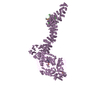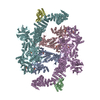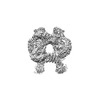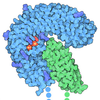[English] 日本語
 Yorodumi
Yorodumi- EMDB-29341: Cryo-EM structure of Rab29-LRRK2 complex in the LRRK2 dimer state -
+ Open data
Open data
- Basic information
Basic information
| Entry |  | |||||||||
|---|---|---|---|---|---|---|---|---|---|---|
| Title | Cryo-EM structure of Rab29-LRRK2 complex in the LRRK2 dimer state | |||||||||
 Map data Map data | ||||||||||
 Sample Sample |
| |||||||||
 Keywords Keywords | Cryo-EM / Parkinson's disease / Kinase / LRRK2 / Rab GTPases / Activation / HYDROLASE | |||||||||
| Function / homology |  Function and homology information Function and homology informationprotein localization to ciliary membrane / caveola neck / negative regulation of protein processing involved in protein targeting to mitochondrion / beta-catenin destruction complex binding / regulation of branching morphogenesis of a nerve / regulation of kidney size / Wnt signalosome assembly / regulation of cell projection organization / tangential migration from the subventricular zone to the olfactory bulb / GTP-dependent protein kinase activity ...protein localization to ciliary membrane / caveola neck / negative regulation of protein processing involved in protein targeting to mitochondrion / beta-catenin destruction complex binding / regulation of branching morphogenesis of a nerve / regulation of kidney size / Wnt signalosome assembly / regulation of cell projection organization / tangential migration from the subventricular zone to the olfactory bulb / GTP-dependent protein kinase activity / regulation of SNARE complex assembly / regulation of neuroblast proliferation / regulation of ER to Golgi vesicle-mediated transport / protein localization to endoplasmic reticulum exit site / peroxidase inhibitor activity / negative regulation of late endosome to lysosome transport / regulation of mitochondrial depolarization / negative regulation of protein targeting to mitochondrion / positive regulation of dopamine receptor signaling pathway / amphisome / regulation of synaptic vesicle transport / regulation of lysosomal lumen pH / regulation of CAMKK-AMPK signaling cascade / co-receptor binding / negative regulation of GTPase activity / positive regulation of intracellular protein transport / host-mediated perturbation of viral process / regulation of dopamine receptor signaling pathway / regulation of neuron maturation / positive regulation of microglial cell activation / regulation of retrograde transport, endosome to Golgi / positive regulation of synaptic vesicle endocytosis / cytoplasmic side of mitochondrial outer membrane / negative regulation of excitatory postsynaptic potential / negative regulation of autophagosome assembly / JUN kinase kinase kinase activity / olfactory bulb development / RAB geranylgeranylation / neuron projection arborization / melanosome organization / striatum development / multivesicular body, internal vesicle / regulation of dendritic spine morphogenesis / mitochondrion localization / cis-Golgi network / protein localization to mitochondrion / cellular response to dopamine / positive regulation of mitochondrial outer membrane permeabilization involved in apoptotic signaling pathway / vacuole / endoplasmic reticulum organization / positive regulation of protein autoubiquitination / Wnt signalosome / negative regulation of protein processing / positive regulation of programmed cell death / retrograde transport, endosome to Golgi / protein localization to membrane / GTP metabolic process / regulation of canonical Wnt signaling pathway / cellular detoxification / syntaxin-1 binding / regulation of reactive oxygen species metabolic process / lysosome organization / Golgi-associated vesicle / clathrin binding / PTK6 promotes HIF1A stabilization / negative regulation of macroautophagy / protein kinase A binding / neuromuscular junction development / regulation of cAMP/PKA signal transduction / regulation of mitochondrial fission / regulation of locomotion / intracellular vesicle / regulation of synaptic vesicle exocytosis / microvillus / Golgi organization / intracellular distribution of mitochondria / positive regulation of T cell receptor signaling pathway / exploration behavior / endoplasmic reticulum exit site / autolysosome / dynein complex binding / positive regulation of receptor recycling / locomotory exploration behavior / negative regulation of Notch signaling pathway / kinesin binding / MAP kinase kinase kinase activity / regulation of synaptic vesicle endocytosis / canonical Wnt signaling pathway / regulation of synaptic transmission, glutamatergic / negative regulation of endoplasmic reticulum stress-induced intrinsic apoptotic signaling pathway / presynaptic cytosol / synapse assembly / Rho protein signal transduction / neuron projection morphogenesis / phagocytic vesicle / cellular response to manganese ion / JNK cascade / endomembrane system / positive regulation of autophagy / dendrite cytoplasm Similarity search - Function | |||||||||
| Biological species |  Homo sapiens (human) Homo sapiens (human) | |||||||||
| Method | single particle reconstruction / cryo EM / Resolution: 3.88 Å | |||||||||
 Authors Authors | Zhu H / Sun J | |||||||||
| Funding support |  United States, 1 items United States, 1 items
| |||||||||
 Citation Citation |  Journal: Science / Year: 2023 Journal: Science / Year: 2023Title: Rab29-dependent asymmetrical activation of leucine-rich repeat kinase 2. Authors: Hanwen Zhu / Francesca Tonelli / Martin Turk / Alan Prescott / Dario R Alessi / Ji Sun /   Abstract: Gain-of-function mutations in , which encodes the leucine-rich repeat kinase 2 (LRRK2), are the most common genetic cause of late-onset Parkinson's disease. LRRK2 is recruited to membrane organelles ...Gain-of-function mutations in , which encodes the leucine-rich repeat kinase 2 (LRRK2), are the most common genetic cause of late-onset Parkinson's disease. LRRK2 is recruited to membrane organelles and activated by Rab29, a Rab guanosine triphosphatase encoded in the locus. We present cryo-electron microscopy structures of Rab29-LRRK2 complexes in three oligomeric states, providing key snapshots during LRRK2 recruitment and activation. Rab29 induces an unexpected tetrameric assembly of LRRK2, formed by two kinase-active central protomers and two kinase-inactive peripheral protomers. The central protomers resemble the active-like state trapped by the type I kinase inhibitor DNL201, a compound that underwent a phase 1 clinical trial. Our work reveals the structural mechanism of LRRK2 spatial regulation and provides insights into LRRK2 inhibitor design for Parkinson's disease treatment. #1:  Journal: bioRxiv / Year: 2022 Journal: bioRxiv / Year: 2022Title: Structural basis of human LRRK2 membrane recruitment and activation Authors: Zhu H / Tonelli F / Alessi D / Sun J | |||||||||
| History |
|
- Structure visualization
Structure visualization
| Supplemental images |
|---|
- Downloads & links
Downloads & links
-EMDB archive
| Map data |  emd_29341.map.gz emd_29341.map.gz | 398.8 MB |  EMDB map data format EMDB map data format | |
|---|---|---|---|---|
| Header (meta data) |  emd-29341-v30.xml emd-29341-v30.xml emd-29341.xml emd-29341.xml | 18.3 KB 18.3 KB | Display Display |  EMDB header EMDB header |
| Images |  emd_29341.png emd_29341.png | 52.9 KB | ||
| Filedesc metadata |  emd-29341.cif.gz emd-29341.cif.gz | 7.2 KB | ||
| Others |  emd_29341_half_map_1.map.gz emd_29341_half_map_1.map.gz emd_29341_half_map_2.map.gz emd_29341_half_map_2.map.gz | 391.8 MB 391.8 MB | ||
| Archive directory |  http://ftp.pdbj.org/pub/emdb/structures/EMD-29341 http://ftp.pdbj.org/pub/emdb/structures/EMD-29341 ftp://ftp.pdbj.org/pub/emdb/structures/EMD-29341 ftp://ftp.pdbj.org/pub/emdb/structures/EMD-29341 | HTTPS FTP |
-Validation report
| Summary document |  emd_29341_validation.pdf.gz emd_29341_validation.pdf.gz | 824.5 KB | Display |  EMDB validaton report EMDB validaton report |
|---|---|---|---|---|
| Full document |  emd_29341_full_validation.pdf.gz emd_29341_full_validation.pdf.gz | 824 KB | Display | |
| Data in XML |  emd_29341_validation.xml.gz emd_29341_validation.xml.gz | 17.9 KB | Display | |
| Data in CIF |  emd_29341_validation.cif.gz emd_29341_validation.cif.gz | 21.2 KB | Display | |
| Arichive directory |  https://ftp.pdbj.org/pub/emdb/validation_reports/EMD-29341 https://ftp.pdbj.org/pub/emdb/validation_reports/EMD-29341 ftp://ftp.pdbj.org/pub/emdb/validation_reports/EMD-29341 ftp://ftp.pdbj.org/pub/emdb/validation_reports/EMD-29341 | HTTPS FTP |
-Related structure data
| Related structure data |  8fo8MC  8fo2C  8fo9C  8smcC M: atomic model generated by this map C: citing same article ( |
|---|---|
| Similar structure data | Similarity search - Function & homology  F&H Search F&H Search |
- Links
Links
| EMDB pages |  EMDB (EBI/PDBe) / EMDB (EBI/PDBe) /  EMDataResource EMDataResource |
|---|---|
| Related items in Molecule of the Month |
- Map
Map
| File |  Download / File: emd_29341.map.gz / Format: CCP4 / Size: 421.9 MB / Type: IMAGE STORED AS FLOATING POINT NUMBER (4 BYTES) Download / File: emd_29341.map.gz / Format: CCP4 / Size: 421.9 MB / Type: IMAGE STORED AS FLOATING POINT NUMBER (4 BYTES) | ||||||||||||||||||||||||||||||||||||
|---|---|---|---|---|---|---|---|---|---|---|---|---|---|---|---|---|---|---|---|---|---|---|---|---|---|---|---|---|---|---|---|---|---|---|---|---|---|
| Projections & slices | Image control
Images are generated by Spider. | ||||||||||||||||||||||||||||||||||||
| Voxel size | X=Y=Z: 1.06 Å | ||||||||||||||||||||||||||||||||||||
| Density |
| ||||||||||||||||||||||||||||||||||||
| Symmetry | Space group: 1 | ||||||||||||||||||||||||||||||||||||
| Details | EMDB XML:
|
-Supplemental data
-Half map: #2
| File | emd_29341_half_map_1.map | ||||||||||||
|---|---|---|---|---|---|---|---|---|---|---|---|---|---|
| Projections & Slices |
| ||||||||||||
| Density Histograms |
-Half map: #1
| File | emd_29341_half_map_2.map | ||||||||||||
|---|---|---|---|---|---|---|---|---|---|---|---|---|---|
| Projections & Slices |
| ||||||||||||
| Density Histograms |
- Sample components
Sample components
-Entire : Rab29-LRRK2
| Entire | Name: Rab29-LRRK2 |
|---|---|
| Components |
|
-Supramolecule #1: Rab29-LRRK2
| Supramolecule | Name: Rab29-LRRK2 / type: complex / ID: 1 / Parent: 0 / Macromolecule list: #1-#2 |
|---|---|
| Source (natural) | Organism:  Homo sapiens (human) Homo sapiens (human) |
-Macromolecule #1: Ras-related protein Rab-7L1
| Macromolecule | Name: Ras-related protein Rab-7L1 / type: protein_or_peptide / ID: 1 / Number of copies: 2 / Enantiomer: LEVO |
|---|---|
| Source (natural) | Organism:  Homo sapiens (human) Homo sapiens (human) |
| Molecular weight | Theoretical: 20.239076 KDa |
| Recombinant expression | Organism:  |
| Sequence | String: MGSRDHLFKV LVVGDAAVGK TSLVQRYSQD SFSKHYKSTV GVDFALKVLQ WSDYEIVRLQ LWDIAGLERF AAMTRLYYRD ASACVIMFD VTNATTFSNS QRWKQDLDSK LTLPNGEPVP CLLLANKCDL SPWAVSRDQI DRFSKENGFT GWTETSVKEN K NINEAMRV LIEKMMRNS UniProtKB: Ras-related protein Rab-7L1 |
-Macromolecule #2: Leucine-rich repeat serine/threonine-protein kinase 2
| Macromolecule | Name: Leucine-rich repeat serine/threonine-protein kinase 2 / type: protein_or_peptide / ID: 2 / Number of copies: 2 / Enantiomer: LEVO / EC number: non-specific serine/threonine protein kinase |
|---|---|
| Source (natural) | Organism:  Homo sapiens (human) Homo sapiens (human) |
| Molecular weight | Theoretical: 286.427656 KDa |
| Recombinant expression | Organism:  Homo sapiens (human) Homo sapiens (human) |
| Sequence | String: MASGSCQGCE EDEETLKKLI VRLNNVQEGK QIETLVQILE DLLVFTYSEH ASKLFQGKNI HVPLLIVLDS YMRVASVQQV GWSLLCKLI EVCPGTMQSL MGPQDVGNDW EVLGVHQLIL KMLTVHNASV NLSVIGLKTL DLLLTSGKIT LLILDEESDI F MLIFDAMH ...String: MASGSCQGCE EDEETLKKLI VRLNNVQEGK QIETLVQILE DLLVFTYSEH ASKLFQGKNI HVPLLIVLDS YMRVASVQQV GWSLLCKLI EVCPGTMQSL MGPQDVGNDW EVLGVHQLIL KMLTVHNASV NLSVIGLKTL DLLLTSGKIT LLILDEESDI F MLIFDAMH SFPANDEVQK LGCKALHVLF ERVSEEQLTE FVENKDYMIL LSALTNFKDE EEIVLHVLHC LHSLAIPCNN VE VLMSGNV RCYNIVVEAM KAFPMSERIQ EVSCCLLHRL TLGNFFNILV LNEVHEFVVK AVQQYPENAA LQISALSCLA LLT ETIFLN QDLEEKNENQ ENDDEGEEDK LFWLEACYKA LTWHRKNKHV QEAACWALNN LLMYQNSLHE KIGDEDGHFP AHRE VMLSM LMHSSSKEVF QASANALSTL LEQNVNFRKI LLSKGIHLNV LELMQKHIHS PEVAESGCKM LNHLFEGSNT SLDIM AAVV PKILTVMKRH ETSLPVQLEA LRAILHFIVP GMPEESREDT EFHHKLNMVK KQCFKNDIHK LVLAALNRFI GNPGIQ KCG LKVISSIVHF PDALEMLSLE GAMDSVLHTL QMYPDDQEIQ CLGLSLIGYL ITKKNVFIGT GHLLAKILVS SLYRFKD VA EIQTKGFQTI LAILKLSASF SKLLVHHSFD LVIFHQMSSN IMEQKDQQFL NLCCKCFAKV AMDDYLKNVM LERACDQN N SIMVECLLLL GADANQAKEG SSLICQVCEK ESSPKLVELL LNSGSREQDV RKALTISIGK GDSQIISLLL RRLALDVAN NSICLGGFCI GKVEPSWLGP LFPDKTSNLR KQTNIASTLA RMVIRYQMKS AVEEGTASGS DGNFSEDVLS KFDEWTFIPD SSMDSVFAQ SDDLDSEGSE GSFLVKKKSN SISVGEFYRD AVLQRCSPNL QRHSNSLGPI FDHEDLLKRK RKILSSDDSL R SSKLQSHM RHSDSISSLA SEREYITSLD LSANELRDID ALSQKCCISV HLEHLEKLEL HQNALTSFPQ QLCETLKSLT HL DLHSNKF TSFPSYLLKM SCIANLDVSR NDIGPSVVLD PTVKCPTLKQ FNLSYNQLSF VPENLTDVVE KLEQLILEGN KIS GICSPL RLKELKILNL SKNHISSLSE NFLEACPKVE SFSARMNFLA AMPFLPPSMT ILKLSQNKFS CIPEAILNLP HLRS LDMSS NDIQYLPGPA HWKSLNLREL LFSHNQISIL DLSEKAYLWS RVEKLHLSHN KLKEIPPEIG CLENLTSLDV SYNLE LRSF PNEMGKLSKI WDLPLDELHL NFDFKHIGCK AKDIIRFLQQ RLKKAVPYNR MKLMIVGNTG SGKTTLLQQL MKTKKS DLG MQSATVGIDV KDWPIQIRDK RKRDLVLNVW DFAGREEFYS THPHFMTQRA LYLAVYDLSK GQAEVDAMKP WLFNIKA RA SSSPVILVGT HLDVSDEKQR KACMSKITKE LLNKRGFPAI RDYHFVNATE ESDALAKLRK TIINESLNFK IRDQLVVG Q LIPDCYVELE KIILSERKNV PIEFPVIDRK RLLQLVRENQ LQLDENELPH AVHFLNESGV LLHFQDPALQ LSDLYFVEP KWLCKIMAQI LTVKVEGCPK HPKGIISRRD VEKFLSKKRK FPKNYMTQYF KLLEKFQIAL PIGEEYLLVP SSLSDHRPVI ELPHCENSE IIIRLYEMPY FPMGFWSRLI NRLLEISPYM LSGRERALRP NRMYWRQGIY LNWSPEAYCL VGSEVLDNHP E SFLKITVP SCRKGCILLG QVVDHIDSLM EEWFPGLLEI DICGEGETLL KKWALYSFND GEEHQKILLD DLMKKAEEGD LL VNPDQPR LTIPISQIAP DLILADLPRN IMLNNDELEF EQAPEFLLGD GSFGSVYRAA YEGEEVAVKI FNKHTSLRLL RQE LVVLCH LHHPSLISLL AAGIRPRMLV MELASKGSLD RLLQQDKASL TRTLQHRIAL HVADGLRYLH SAMIIYRDLK PHNV LLFTL YPNAAIIAKI ADYGIAQYCC RMGIKTSEGT PGFRAPEVAR GNVIYNQQAD VYSFGLLLYD ILTTGGRIVE GLKFP NEFD ELEIQGKLPD PVKEYGCAPW PMVEKLIKQC LKENPQERPT SAQVFDILNS AELVCLTRRI LLPKNVIVEC MVATHH NSR NASIWLGCGH TDRGQLSFLD LNTEGYTSEE VADSRILCLA LVHLPVEKES WIVSGTQSGT LLVINTEDGK KRHTLEK MT DSVTCLYCNS FSKQSKQKNF LLVGTADGKL AIFEDKTVKL KGAAPLKILN IGNVSTPLMC LSESTNSTER NVMWGGCG T KIFSFSNDFT IQKLIETRTS QLFSYAAFSD SNIITVVVDT ALYIAKQNSP VVEVWDKKTE KLCGLIDCVH FLREVTVKE NKESKHKMSY SGRVKTLCLQ KNTALWIGTG GGHILLLDLS TRRLIRVIYN FCNSVRVMMT AQLGSLKNVM LVLGYNRKNT EGTQKQKEI QSCLTVWDIN LPHEVQNLEK HIEVRKELAE KMRRTSVE UniProtKB: Leucine-rich repeat serine/threonine-protein kinase 2 |
-Macromolecule #3: GUANOSINE-5'-DIPHOSPHATE
| Macromolecule | Name: GUANOSINE-5'-DIPHOSPHATE / type: ligand / ID: 3 / Number of copies: 2 / Formula: GDP |
|---|---|
| Molecular weight | Theoretical: 443.201 Da |
| Chemical component information |  ChemComp-GDP: |
-Macromolecule #4: ADENOSINE-5'-TRIPHOSPHATE
| Macromolecule | Name: ADENOSINE-5'-TRIPHOSPHATE / type: ligand / ID: 4 / Number of copies: 2 / Formula: ATP |
|---|---|
| Molecular weight | Theoretical: 507.181 Da |
| Chemical component information |  ChemComp-ATP: |
-Experimental details
-Structure determination
| Method | cryo EM |
|---|---|
 Processing Processing | single particle reconstruction |
| Aggregation state | particle |
- Sample preparation
Sample preparation
| Buffer | pH: 8 |
|---|---|
| Vitrification | Cryogen name: ETHANE |
- Electron microscopy
Electron microscopy
| Microscope | FEI TITAN KRIOS |
|---|---|
| Image recording | Film or detector model: GATAN K3 (6k x 4k) / Average electron dose: 58.8 e/Å2 |
| Electron beam | Acceleration voltage: 300 kV / Electron source:  FIELD EMISSION GUN FIELD EMISSION GUN |
| Electron optics | Illumination mode: OTHER / Imaging mode: BRIGHT FIELD / Nominal defocus max: 1.8 µm / Nominal defocus min: 0.6 µm |
| Experimental equipment |  Model: Titan Krios / Image courtesy: FEI Company |
- Image processing
Image processing
| Startup model | Type of model: NONE |
|---|---|
| Final reconstruction | Resolution.type: BY AUTHOR / Resolution: 3.88 Å / Resolution method: OTHER / Software - Name: cryoSPARC / Number images used: 96502 |
| Initial angle assignment | Type: OTHER |
| Final angle assignment | Type: OTHER |
 Movie
Movie Controller
Controller














 Z (Sec.)
Z (Sec.) Y (Row.)
Y (Row.) X (Col.)
X (Col.)




































